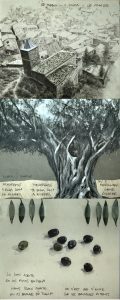
The Mudéjar Wood project presents an online video-publication as an exhaustive guide to all the manifestations of historic carpentry located in the towns of Mudéjar Territory.
The research stay began with a visit to the twelve localities with Mudejar carpentry works: Torralba de Ribota, Tobed, Cervera de la Cañada, Maluenda, Mesones de Isuela, La Almunia, Calatayud, Daroca, Illueca, Aniñón, Alagón and Borja. In this first phase of fieldwork, each of the pieces was examined in depth by Ángel María Martín (Avila, 1963), a professional with more than 20 years of experience in the world of Spanish historical carpentry in the fields of restoration, new works and training.
In a second phase, explanatory videos were made on the technical and stylistic characteristics of the works and photographs were taken to illustrate the online publication. Subsequently, the edition was completed with documentation and research work in the bibliography and archives on the historical trajectory of each work, from its construction to the present day, including the different restoration and conservation processes. Finally, a glossary of key terms in architecture and historical carpentry has been compiled to make it easier to follow the explanations.
The aim of the stay and the resulting publication has been to communicate and highlight the artistic manifestations in wood, authentic hidden gems of Aragonese Mudejar art. Data on Mudejar heritage has been updated and knowledge of the traditional techniques of Mudejar carpentry has been promoted from a structural, constructive and stylistic point of view, in each of the typologies analysed: alfarjes, a ceiling with a framework of limes, two doors and a carrillón.
The project closes with three reflections that seem to us to be unquestionable:
- Firstly, that despite the progress made and the extraordinary achievements of the last few decades, there is still a need to continue with the task of disseminating and enhancing the value of Aragon’s Mudejar heritage, contributing to its protection and conservation.
- It is noted that in rural areas, far from large population centres, it is increasingly difficult to understand and value cultural heritage.
- That wood, along with brick, ceramics and plaster, was also a material used in Aragonese Mudejar art is demonstrated by the valuable examples of its application in a good number of towns in the Mudejar Territory.
LINE OF RESEARCH: (4) Communication and dissemination of Mudejar heritage
AUTHORS: The project team consisted of Myriam Monterde and José Manuel Herraiz, as coordinators; Ángel María Martín, specialist in historical carpentry; Sara Gimeno as documentalist and Emilio Gazo as assistant video and photography technician.


